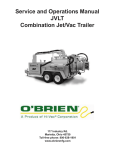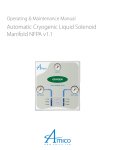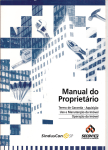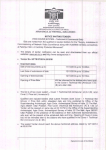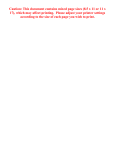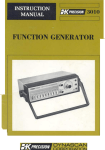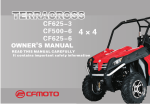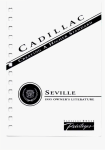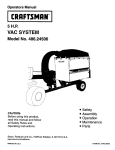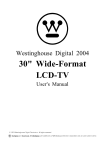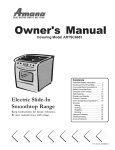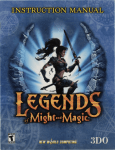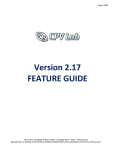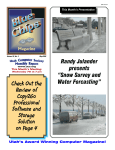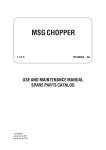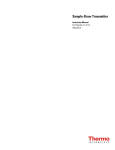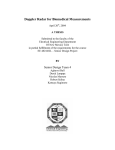Download Specifications of Advance Life Support Ambulance ( 1652KB)
Transcript
.
•
_"'.',
.....'
...
1.
~.
IJ·
"
SPECIFICATIONS OF ADVANCE
liFE SUPPORTAMBULANCE
fOR PROCUREMENT
UNDER
NATIONAL HIGHWAY ACCIDENT RELIEFSERVICE SCHEME (NHARSS)
An Advance LifeSupport Ambulonce is a vehicle that shiftsthe reasonably stable
patient from one hospital/ clinic to other hospital for further treatment. It can also
be utilized in the case of any eventuality for transportation of accident victims or
any other patient from accident site to nearest possible hospital.
TheAdvance life support ambulance will provide primary and secondary patient
transportation from one place to another without aggravating the injuries and
with sufficient comfort level. .
Theprfmary patfent is one who is on a self loading. collapsible stretcher. whereas
secondary paHent is on a squad bench. Thissquad bench can additionally be
utilized to transport relative(s} of a patient. alternatively more than one patient /
victim. who can travel in seating mode/on a stretcher on this bench. The
ambulance patient loading should be from the rear door opening side-wise.
General Vehicular Designand FloorPlans:
Thisambulance should be either of eM VR approved monocoque design or
should be fully built on chassis of a major Indian DE manufacturer of repute. In
either case, the vehicle manufacturer should have dealership network and repair
servicingfacility in major cities of India.
The ambulance should be designed, built and complete with operating
accessories as specified herein. The assembly, sub-assembly and equipment
should be integrated in such a way so as to enable the vehicle function in a
reliable way and in a sustained fashion for durability. safety and comfort.
Thedesign of the vehlcte and the specified equipment shall permit accessibility
for servicing / replacement and adjustment of components / parts and
accessories.with minimum disturbance to other components and systems. Also,
the bidder shall ensure that sufficient re-inforcement is provided to protect the
components, assemblies, pipelines, tUbing, wirings, etc which are susceptible to
damage / hazards encountered
during on-road, off-road. cross-country
operations of ambulance.
The emergency medical care vehicles, including chassis.ambulance body,
equipment, devices, medical accessories and electronic equipment shall be
brand new standard commercial products. tested and certified to meet or
exceed the requirements of these specifications.
.~ or
"
Vehicle Operation, Performance and Physical Characteristics
The ambulance
Vehicles Rules.
should meet the axle load distribution as per Central Motor,
The weight distribution between right hand side wheel(s) and left hand side
wheel(s) (individually) should not exceed 5 % of the axle load.
To provide for maximum safety. the manufacturer sholl locate vehicle mounted
components, equipments and supplies to provide a vehicle that is laterally
balanced and has front I rear loading that is proportional to axle loading.
The manufacturer under GVW condition and unladen condition should measure
the Centre of Gravity (CG) and declare the stability for roll-over angie., The gross
payload applicable herein is maximum 1.5 ton, (This payload is after the
ambulance is fully built accommodating all necessary fitments, equipment, tools,
etc).
.
Overc;JlIDImensions
Theoverall length of the ambulance should not exceed 550 em. excluding rear
steps and bumper guard.
Theoverall width ofthe ambulance should not exceed 244 cm, excluding mirror,
lights and safety accessories.
Theoverall height of the ambulance should not exceed 279 cm including roof
mounting equipment (viz. Alc etc) and excluding Radio Antenna.
TheBnlshed Boor (loadIng) heIght shall be a maximum of 84cm.
Overhang
Thefront overhang of the vehicle shall not exceed 40 % of the wheelbase
(excluding fro'nt tow hook). The rear overhang of the vehicle shall not exceed 60
% of the wheelbase (excluding rear entry-steps and toe hook).
Ground Clearance,
Angle of Approach,
Departure and Ramp Breakover
As per CMVR for the specific vehicle category.
Diesel EngIne and Power TraIn
The diesel engine should meet BS III requirements of CMVR TAP Document,
prevailing -inthe state of registration of the vehicle as on date of commissioning.
The engine coolants, lUbricants, oil etc should be able to perform satisfactorily
under normal climate conditions for all seasons across India. The accessibility to
Page 2 of31
.'
•
.. --~.<~
"
.'
('i ~~/
.
check, maintain and refueling for oil, lubricants etc should be easily abees-sibi~
and ma~~~d/ symbolized..
Theengine horse power, torque, drive train and transmissionand tyres should be
such that it should meet the following requirements:
I. ·Thevehicles sholl be capable of a sustained speed of not lessthan 90km/h
over dry, hard surfaced, level roods
2. The engine' of the vehicle should be of minimum 75 HP generation
capacity,
3. The vehicle should be able to negotiate hilly area gradients and sharp
bends.
4. As regards gradeability, the ambulance should be able to negotiate min.
gradeability of 7 deg. For hilly areas it is desirable to have more than 10.2
deg.
Thevehicle should meet the Central Motor Vehicle Rulesrequirement of grade
ability.
Steering & Suspension
Ambulance should be fitted with power assisted steering system, for easy and
comtortoble steerability of the vehicle at low and high speeds. The vehicle also
shouldcomply with the steering requirements, as per CMVR.
Vehicle shall be equipped with laterally matched sets(front and rear) of spring,
torsion, or air suspensIon system components suitable to ensure comfortable ride
and safety of the patient. The suspensionmaybe reinforced suitable to provided
additional comfort.
•
Tyres
Thetyres fitted on the ambulance should be Radial tyres (with / without tube) of
Indian make, and type approved by any of the testing agencies specified. in
CMVR,1989 for its load, speed performance and durability..
A sparewheel should be housed at appropriate place and indicated.
Brakes
Thevehicle should meet all requirements of CMVR. Though it is desirable that the
ambulance be equipped with ABSSystem, fitment of the same isoptional.
Fuel Tank (fuel Storage Capacity)
Page3 of31
,'Ii ...
, \..;--,
The fuel tank shouldbe approved os a stand-alone component, as per Indian
Standard/ CMVR requirement.for aii necessarysafety aspecls and·oerforrnonce.
The capacity of the fuel tank shouldbe such that it should suffice the need 350
km with one-timefilling.Thefueltank shouldbe with fuel fill splashplates.
Cab· Body Provision
Additionally,driver'scobin shouidDeprovided wirn _
a.
b.
c.
d.
e.
f.
g.
h.
i.
j.
k.
I.
m.
Dual sunvisors(podded)
Armrests,mounted on each sidedoor
Compartment ventilation,other than windows
Key operated ignition / starterswitch
FuelGauge{s)
Enginetemperature gauge
Spef;.,_dometer
with odometer
Environmentalcontrols (air conditioning etc)
Seatbeltsand shoulderharnessfor driver and passenger
Dual outside mirrors
Cob lightingend controls.
Electrichom(s}
RearDooropen indicator
Body Structure
-Ambulances of monocoque designshould have body structureas'per CMVR.
In ambulances built on OEM-Chassis,the ambulance should be fabricated at an
. IS 16949:2002or equivalent certified facility & the fabrication should meet or
exceed the followingcriteria:
Combination of 10/12/14G pressedsection & MSsquare tubes, structurewith hot
dip phosphating processfor anti-corrosion,rolled "C" channels for the floor cross
memberswith pressedsection for the roof & floor longitudinar..
Body crossmember shall be welded vAthlong membersusinggusset and shall be
designed to support the Ambulance body rigidly and withstand tensional loads.
Complete structurewelding with C02 process.
Drip rail{s} shall be provided around the entire body and have drain points at
each corner. Bodystructure shall include gussetingto provide diagonal strength.
Exterior panelling.shouldbe with J 8G aluminium sheets& coilsfor rooftop.
Page40(31
"_
..
II
•
,_,
•
.,
(
.
...
!~
In case of fabrication using the Sandwich Panel Technology, The walls shall be
made gf, joint lesssondwicr, elements with
• Outer & InnerSkin- Minimum 1.5MM Thick,TrafficWhite (RAL1016,R-252,G255. B-255)dyed Glass fiber laminates with high standard gel coat layer
based on isophthatic acid with UVstabilizerof reputed brand
• CFC free. high performance. rigid polyurethane block foam, minimum 44
mm thicknessof reputed' brand.
Theambulance should also have tow hook in the front as well as rear.
Fron' & Rear show
Original cowl front show with single piece c.urved windscreen laminated glass,
front bumper and FRPcentre grillwith headlight housing.
Rear show with single piece screen glass on both flaps of the door and MS/FRP
bumper to suitfront/rear facia.
SIde Windows
FullSliding windows/ combination. of fIXing & sliding aluminium frame / tiltable
aluminium frame square windows with toughened tinted glasses.
Window frames should be black powder coated. Curtains for rear/side windows
to ensure patient privdcy in patient compartment shouldbe provided.
.
Safety Glass , '
Theambulance should be fitted with safety glassesas per CMVR.
Windscreen WipIng System
Thefront windshield should have screen wiping system,electrically operated. The
washersystemshould have minimum '.5 litrestank capacity.
The tank should be located at an appropriate location and should be easily
accessible for re-filling.
.
Paffent Compartment
Thepatient compartment shall have the provisionsfor housing:
- a roll-in self-foldable/collapsible stretcher for the primary patient
- a folding/scoop stretcher
- a squad bench to accommodate minimum four sitting patients or the
.above mentioned folding/scoop stretcher
Page 5 of31
',I
a washbasin with fool operated top
. SoopDispenser and Tissue Di3pe,,:;e.
Medical Equipment os specified
Various drugs and consumables
Cool/worm box
-
Other Equipment os specified
Patient comportment volumetric space sholl be sufficient in size to transport
occupants and accommodate / store all stretchers, squad / cots and litters.
The length of the patient compartment measured from partition to the inside
edge of the reor loading door at the floor level shall be at least 3 J 0 cm.
The length should provide at least 64 cm and not more than 76 cm of
unobstructed space at the head of the primary patient, when measured from the
face of the backrest of the Doctor's/Paramedic's Seat to the forward edge of the
stretcher.
.
A min of 25 cm shall be provided from the end of the stretcher to rear loading
door, to permit clearance for any traction or long-board splints.
The wIdth of the compartment after installation of cabinets shall provide 46 ± J 5
cm clear aisle walkway between stretcher / cot and the base of squad bench,
with the cot located in the street side (non-centred) position.
The patient compartment shall provide at least J 52 cm height over the primary
patient area, measured from floor to ceiling panels.
An access wfndow between Driver's Cabin and Patient Compartment should be
provided at appropriate loca~ion for visual checks and voice communication
between the cabin and patient compartment. Thiswindow should be latch able
from the patient cabin side and should be transparent, shatter proof and shall
have adjustable opening.
Complete Interior panefllng of the sidewalls, partition between patient cabin and
driver cabin, roof (of both patient and driver cat;>inJ& bock door panels should
made from long life superior quality Fibre Reinforced Polymer (FRP)or ABS. (not
applicable for Sandwich Panel Fabrication)
The FRP/ABSwherever used, should have the "following characteristics:
• Thickness- minimum 4.0 mm for FRPor 3.0mm for ABS
• Inbuilt colour
• Fire retardant as per IS- 6746 of J 988 or latest
• Should meet lamination standard IS- J 0 J 92 or latest
Page60f31
'..
,
.; ,_ ...
~~,
Thereshould be PUF/ PU min. 12 mm thick or thermocol min. 40mm thick or
equivalent insulotion for reduction of heat and noise- within the patient
comportment. The insulating material should be non-toxic, non-settling type,
verminproof. mild dew proof and non hygroscopic.
Provisionshould be mode for placement of power switches / sockets/ manifold
outlets/ major medical equipment like DeFibrillator. Monitor, Ventilator. etc in FRP.
with sufficient reinForcement for holding them securely while in transit.
Unobstructed access & full functionality of the fittings/equipment as desired for
optimal patient care must be ensured during this process.
Adequate provision for storage of medicines/consumables/equipment should be
made by providing lockable cabinets & drawers. Theseshould be made of fire
retardant material, in sync with the ambulance's internal look and feel. The
drawers should be on steel guide ways (of reputed brands only) & provided with
ball socket locksto arrest the drawers opening during motion of ambulance.
Thefloor should be fitted with minimum 3.125mm aluminium cladded chequered
sheet or fire retardaht 12mm marine plywood with 2mm thick Anti-skidPVC vinyl
matting or 'FRP with Anti-s~idcoating. .
Thefootsteps should be provided appropriately, if the patient compartment floor
is more than 46 cm above. the ground. Thisstep should be transverse length
equivalent to the door opening. If there is more than one step, the steps should
be equidistant. The steps shall not be located or exposed to the interior of the
ambulance, even when the rear door is closed. The step freed shall have
minimum depth of 13 cm and max. depth of 27 cm. If the steps protrude more
than 18cm from the rear the vehicle, fold-up steps should be provided.
The complete interior should be edgeless and suitable for easy cleaning /
scientific fumigation / treatment of. di.sinfectants, The ambulance interiorsshould
be designed with care to avoid injuriesby fall of equipment or cylinder on persons
insidethe ambulance in case of turmoil due to bad road conditions. Upholstered
padding/cushions shall be provid~d at the upper interior areas of the door
frames.Similarpadding/cushions also shall be furnished at other areas that may
be capable of causing injury. Thefinish of internal & externalpatient/driver cabin
shouldmeet CMVR requirements of externalprojection.
Doors:Two side opening patient compartment door openings shall be provided
at the rear of the ambulance. Thereshall be an optional door opening on the left
forward side and two side opening doors the rear of the body for loading a
patient on a cot. All ambulance body doors shall be designed for easy release
and should be lockable to ensurethe safety of the equipment when the vehicle is
parked. A "Door-Open" warning device shall Signal (indicate in the cab) when
doors are not closed, Each door shall have effective compressionor overlapping
sealsto prevent leakage of exhaustfumes, dust, water, and air.
Page 70f31
Theoptionol side opening door of the patient compartment shall be a sliding-type
door one-snouo provide a minimum iett-sioe clear opening of 7-&cm wide and of .
160cm high or the monocoque chassismanufacturer's standard opening. Should
the rear doors be rendered inoperable, the side door and interior configuration
shall permit emergency removal of the patient either on a backboard or other
device used for spinal immobilization. The side opening door, though desirable, is
optional.
The rear loading door for entry into Patient Compartment shall not be 'Iessthan
117cm in height with minimum width of 112 cm and the door opening should be
side-ways (preferably 270 degrees opening). Each door should be hinged at least
at two places and should have firm latching provision.
When doors are not 270 degrees opening, a red light or reflector, minimum 7.6-cm
(3-in.) diameter, shall be installed, one on the interior surface of the side of each
rear door. The·reflectors shall be so positioned as to provide maximum visibility
when the doors are in the fully open position. The opening of the doorshould be
possible from inside and outside at all times. Under no condition, during travel
mode, this door should open.
A RoII·ln Self Foldable Stretcher (Collapsible Cot)of oreputed
brand (preferably
with capability ·to convert into wheel chair) should be provided for the primary
patient. The said stretched should automatically collapse when wheeled into the
patient compartment over a fixed 'collapsible cot base'. The 'collapslble cot,
base' should preferably have a built in slot to accommodate the scoop, stretcher
and spine board. '
A seat for the Doctor /Paramedlc should be install~d facing towards the rear of
'the patient compartment & it should be near to the primary patient's head for
easy accessibility. Thisseat shall not be less than 40 cm deep, 40 cm wide and 400
cm height. measured to the top of the seat cushion and should have adequate
restrainsfor the passenger.
A Squad bench with backrest suitable to accommodate minimum four sifting
patients or folding/scoop stretcher shall be installed along the side wall. A
minimum 50mm thick high density cushion to be provided for comfort. The squad
bench should be upholstered with waterproof washable cover and should have
adequate restrains for the sitting patients as well as the stretcher.
Grab Rail mode of Stainless steel pipe with proper support / fixing, for ease in
entering shall be installed in, the ceiling. Minimum four IV hooks to be provided at
suitable locations to ensure proper patient care.
A washbasin :Nith foot-operated tap should be pruvided at a suitable location. A
fresh water tank: of minimum 10lts capacity for the wash basin with provision for
easy refilling should be installed. There should be a soap dispenser and tissue
dispenser provided in the vicinity of the washbasin.
Page8of3J
}
,--' ~\
":',--
c
•
~-.
,
.
.
~,---.",.-",""-~
A reliable, robust & easy to use Steriliium/Bactorub/equivalent alcohcil based
hand..~~b dispenser supporting standard off the shelf bo!!!.~sof minimum 500ml
capacity should be provided at a suitable location which should be within easy
reach of the doctor/paramedic. Concealed portable dust bins with spring
loaded lidsfor waste disposalshould be provided at suitable locations.
],
A "GSM Fixed Cellular Terminalwith Caller·id" of reputed brand to enable single
line PSTNsimulation made available from GSM network should be fixed at a
suitable place in the patient cabin keeping in view the caller-id visibilityand the
GSMreception. Thisterminal shall be unlocked, support minimum Dual Band GSM
900/1800MHzand should accommodate a standard ExternalSlM Card (3V, 1.8V).
(GSMSlM Card shall not be provided along with and shall be the responsibilityof
the end-user).
Thisterminal shall be paired with a "2 way Intercom phone" (preferably cordless)
of a reputed brand to enable easy communication between the patient & driver
cabin and also to facilitate calls on the GSM network. Thisinstrument should be
located in the patient compartment at a location within the easy reach of the
doctor/paramedic. The instrument in the driver cabin should be located at an
optimal location. Theseinstrumentsshould have adequate restrainsso as to not
dislodge/fall dl,lringtravel.
A battery powered 'thermo-electric cooler cum- warmer' of minimum 121ts
capacity and capable of running on 12 volts DC / 230 volts AC $hould be
provided at a suitable place. Thisshould allow for a temperature control from -5°C
to + 65°C at + 25°C ambient, step-Iessly controlled with two thermostats and
should be secured firmly so as to ensure it doesn't move in the patient cabin
during travel.
A standard quality LED/Digitalclock to be provided in the patient compartment.
It sholild have a minimum Letter (font) Size of 50 to have bettervisibility.
Two numbers of multipurpose fire extinguishers of ABC Type (151marked &
conforming to BIS:13849-1993or latest) duly filled, of capacity and quantity as per
the provisions of Central Motor Vehicle Rules 1989should be provided. Provision
shallbe made, with straps I Velcro tapes and mounting on the flooring for placing
fire extinguisher.One fire extinguishershall be placed in the Driver'scabin and the
second in patient's compartment, at appropriate location, where it iseasily visible
and symbolized.
All frtments/equipment/outlets/switches/storage
spaces, etc in the patient
compartment should be permanently & clearly labelled in English.The font used
shouldbe easily readable and in contrasting colour of the background.
I
Oxygen Delivery System
Page 90f31
/"'-~.'
•••.
--
.» ~
.
"_
The ornbuionce shallhave r1ospitoi 1,';.)(; fJiped ITI8dicui OXYQBIi,.s.y"stem
(manifold)
capable of storing and supplying medical grade oxygen, The system should
camprise of an oxygen cylinder manifold as specified. a cylinder changing
wrench. chained and clipped with/within the oxygen cylinder compartment; a
pressureregulator;oxygenpiping approved for medical oxygen; a duplex axygen
outlet station with quick-disconnect interface for the primary patient and a
second duplex oxygen outlet station with quick-disconnect interface for the
secondarypatient.'
Themanifold shouldhave oxygen cylindersof 8 or 0 sizeonly {minimum one 0 &
one B type cylinder / equivalent}. An adapter to refill the cylinders trom a bulk
cylinder shouldbe provided.
Themanifold shouldbe so designedthat it shallensureproper fixation of cylinders
duringtravel and shouldensureeasy'q!linder changing and positioning.
Thereshould not be any electrical connection in near vicinityor inside the oxygen
cylinder housing,except pressureregulator integrated with flow control valve.
A medical grade oxygen pressureregulator with inlet filter & static outlet pressure
of 4.J 2 bars / 60 psi shall be provided at the cylinder manifold. It shall incluqe a
pressuregauge, an inlet filter, a safety relief valve; a locking mechanism to
prevent settings from being inadvertently changed; sholl maintain accurate
readingsand calibrations during ambulance operation and not be affected by
the temperature conditions.
Only HIgh 'PressureTubIngapproved for medical oxygen (280bar / 4060psi test
pressure),with male female (5/8 inches)bull nose forged Brassconnectors at both
the ends, to connect it from the oxygen cylinder to the pressureregulator inside
the patient cabin shouldbe used.
Minimumtwo.oxygen outlets for the primary patient, concealed in the side wall
near the patient head end (distance between patient head and oxygen / air
outlets to be less than 89 cm) to be provided - one outlet normally meant for,
Oxygen therapy through flow meter & one meant for driving breathing
, equipment like ventilators, etc.
.
'
A duplex oxygen outlet for the secondary patient at a suitable location on the
oppositeside wall isto be provided.
Theseduplex outlet stationsshall be appropriately labelled and colour coded to
indicate their use with medical grade oxygen. Oxygen outlet stations shall be
installed with sufficient vertical space to accommodate attachment of flow
meters, humidifiers, and nebulizers. T"p.r~ shall olso be sufficient horizontal
clearance to prevent interference with the suction inlet quiCK-disconnect if any
and equipment directly attached thereto.
Page 10 of31
;::,
Two (2) Nos.of 'Oxygen Flow Meter with Humidifier' shall be provided. The Flow
Me~~~sshould be oressurecompensated, be able to regulate the flow from 0 to
J 5 litres per min and should show the actual oxygen flow rate using a floating-ball
indicator. Theflow meters shall be installed vertically so as to not interfere with the
other outlets and should be easily readable from the Doctor's/Paramedic' seat.
The Humidifiershould have a slim impact resistantpolycarbonate bowl with metal
Cap and T type inlet outlet nipples. All the connectors should be of chrome
plated on brassmaterial.
Noise
The ambulance should be designed and assembled of its aggregates and
components so as to meet the noise level requirements in dB rAJ scale, as per IS
3028-1998 and it also should meet the driver inside noiseas per AIS-020.
Necessarily,the noise levels in the patient compartment measured at six different
locations f patient ear, rear side of interior of ambulance, front side of interior of
patient compartment, on left and right side of patient cobin - with reference to
centreline of the cabin 1 should not exceed 80 dB(A.J
Air-Condlffoning
The AC unit should be installed at a suitable location in the patient cabin to
ensurethere is no congestion in the driver/patient cabin. Withall windows & doors
closed, the system should be capable of lowering the cabin temperature to a
maximum of 26 degrees Celsiuswithin 30 minutes from 35 degrees Celsius ambient
temperature. The gas used for Air conditioning should be environment friendly as
per International regulatory requirements. The AC should be of reputed
manufacturer who has pan India service network. Theengine idling rpm should be
so designed and tuned to fulfil the requirements'of AC Unit.Though it isdesirable
that the ambulance be equipped with Heating System for the patient/driver
compartment, titment of the same isoptional.
.
Toensure proper ventilation in case of AC failure, one number each of roof / wall
mounted fan be provided in the driver's cabin and patient compartment.
Sfren
A high quality combination electronic
siren with Integrated Public AddreSSing
System of minimum JOOW(PMPO) shall be provided. The siren's controls should
have full range volume control and should permit the following sounds:Manual,
Wail, and Yelp. The siren sweep rate should be 10-18 cycles per minute
(ambulance mode). The microphone should be of a nOise-cancelling type.
Siren/Speakersshpll not protrude beyond the face of the bumper or bumper
guards if provided in there.
The control panel for this system should.be fixed at a suitable location in the driver
compartment.
PageII ofJ.
:1"
Signalling devices, direction indicators & stop lamps
The ambulance should be Fitted with signalling devices, viz, Four chamber rear
signalling devices, comprising of • Parking signalling device,
• Reverse signalling device,
• Broke signalling device and
• Direction Indicators signoilirlQ device
Also, ambulance should be fitted with front head lamps, so as to give sufficient
illumination on the road with aid of high beam and low beam. .
Further, signalling devices should include fitment of front direction indicators
(including front and rear parking indicator) for aid during turning / parking
purpose.
Signalling devices, direction indicators and stop lamps should meet
requirements of Central Motor Vehicles Rules # 102, 103,104, 105 & 106.
the
Fitment of fog lamp is mandatary for a" ambulances.
Besides aforementioned lighting system, all ambulances should include a beacon
lamp (mounted at roof top, having three flashers on both sides of the ambulance.
The beacon shall be rhombic shaped, double layered structure, combination of
continually lit tuming lights. It should have high luminance, voltage 12V DC & a
power of 92 ± '8W.
Theambulance should have minimum fitment, as follows:
Sr.
Description of Lamps
Colour
No.
I.
Headlamp
White
2.
3.
4.
5.
6.
7.
B.
9.
10.
II.
12.
13.
14.
Front side marker lamp
Front Side Reflector
Front turn signal (includes vehicular
hazard warning signal flasher}
Rear side marker lamp
Rear Side reRector
Rear Reflector
....
Rear Stop, Tail and
Turn Signal lamp, includes vehicular
hazard warning signal flasher
Rear backup lamp
Rear License Plate lamp
Roof Mounted bar, consisting of two
segments.
Rear flood flight
Side flood lights
Fog
lamps, in the front
_ _..
Amber
Amber
Amber
Red.
Amber
Red
Red
Amber
White
White'
White
White
White
Qty
02 MandatQl}'_
04 (Optional)
02
02
02
02
02
02
02
01
01
02
01
02
02
Page J2 of31
8-(-
•
.,
.'
"i~'
@
,_,_
.,
Lig~r.ingand IIIuminati,on (Exterior and tnterlor)
The basic exterior ambulance lighting should meet the day as well as night-time
running lightsrequirements.
TheFrontand rear side marker lamps should flash in conjunction with the direction
indicators.
Theflood lights and spot lights should be operable as and when desired by the
user.Butthey must be provided for easy handling.
Thelight assembliesshould be stainlesssteel or plastic or weather proof material.
The installation of such lights should not cause electrolysis/ corrosion of light
housingor vehicle body.
Theroof mounted bar emergency light system should provide 360 degrees of
conspicuousityduring its mission.The other lighting systemloads of alternator base
shouldnot hamper the performance of emergency lights.
lamps and its assemblies,reflectors should meet the photometric, chromaticity
and physical requirements of RuleNo. 124of CMVR.
Thehead-lamp levelling should be provided either automatic or manual.
Loadinglights shall provide minimum 500 candle power beam and shall illuminate
the area surrqunding the back loading doors.
Loadinglight(sJshall automatically be activated when rear doors are opened.
Thereshould be provision for spot Ught to use at night times for surveillance. The
electrical gadget should be able to manoeuvre through 360degrees and shall be
manually operated.
Driver'scompartment room light, instrument panel light, master switch panel and
console light should be adeqiJately provided.
Thereshould not be any reflecting or glaring surfaces inside the driver cabin,
which would distract driver's attention.
Fla~hing and audio alarms in the driver cabin should be so provided, so as not
distractdriver's attention during motion.
Interior PaHent Compartment
IIIumlnatfon:
The nominal light illumination required in the patient compartment should not be
less than J 5 foot candelas, when measured along the centreline of the floor
Page 13 of31
~~b
--
,
(~
~:without any ambient light. The minimum volume of the patient compartment
con5id~r~dhereisminimu(J1
9.2LuDic '",efers.
The primarypatient squad I stretchershall be prpvided with 35 foot candelas of
illuminationmeasuredon at leosl 90 % of the squad I stretchersurface.
Thepatient compartment dome light (in the dimming setting) and loading lamp
shallbe automatically activated when the patient compartment door ore open.
All interior doom lighting including check out lights shall be flush mounted and
shallnot protrude more than 3.8 cm. Theflorescent light or CFllights can be used.
in place of incandescent lights.which fulfil the above requirements.
The lamps shouldbe firmlysecured and should not get loose or fall down during
vehicle movement or vibration.
Check Ughts
Thecheck lights shall be furnishedwith at least 6 candle power tamps or equal
and with five minute timer switches.The checkout light one should be located
towardsthe front and one should be at the rear of the patient compartment.
Electrical Requirements
In ambulance, there should be two types of electrical design fitment and
performance requirements.
1. Electrical power generated by the integrated alternator with engine. This
altemator power generated should meet the requirement of automobile
lighting, signalling, roof mounted bar, beacon lamps, visual and audible
Gllcirrns,
including HVACrequirements.
Thealternator of the vehicle should be heavy duty to fulfil all required loads
mentioned. Moreover, it should also provide additional 20 % (i.e. 120 %) of
itsfull rated output, for continuousoperation ..
2. For auxiliary power requirementsof the patient cabin - An inverter to be
installed in a suitable place in the vehicle, which will fulfil the power
requirements of medical equipments, interior illumination devices lamps,
bulbs, tubes,entrance iIIuminafion,spot lights,etc.
Solfd State Inverter for Onboard 220-V Ale Power
The ambulance shall have onboard a Solin state InvArierof reputed brand to
meet with the patient compartment power requirementsfor medical equipment,
interior illumination devices lamps, bulbs, tubes, entrance illumination,spot lights,
etc.
Page 14 of31
•
.~,
..~+
(9:J
<.:»>
The invertershould be of true sine wave type and should be of sufficient capacity
so as to meet all the electrical power requirements in the patient compartment
for orninirnorn of two (2) hourson full.load during travelling--modeof the vehicle.
The inverter batteries should be situated outside the patient compartment at 0
suitable location.
There should be a circuit breaker provided in driver cabin to isolate the inverter
from down line connectivity and indicate "on" or "off" position. Thiscircuit breaker
should be labelled and housed at an easily accessible location while also
ensuringaccidental switching off.
The inverter shall have the facility for charging from vehicle alternator (when
vehicle ismobile) & 220V AC (when vehicle isstationary).
.
Externalcharge port with spring loaded lid suitable for AC charging of the inverter
batteries should be provided an the exterior of the vehicle at a suitable place.
10Meter length, Three (3) core, 10 gauge! equivalent charging wire with high
quality male three pin ends to be provided. Thiswire should be housed at a
suitable and easilyaccessible location in the ambulance.
Radio Frequency Interference (RFf)
The ambulance electrical/electronic
and mechanical equipment in running
rnode / on condition, should meet the Radio Frequency lnterference standards
[ElectroMagnetic Interference (EMI)AIS- 004-19991.
Electrical Receptacles In PaBent Compartment
.'
Thereshould be at least three numbers of 230 V marked receptacles (each with a
switch and a socket with combination of 5 & 15AMPS)and two receptacles for 12
V DC, of reputed make meeting IS1293 standards. Thesockets shall be made up
of an industrial grade thermo set elecfrical insulation material and resistheat and
fire. The SOCKets
to ensure larger area of contact with
. shall have tubular contacts
.
the pin. Thering springsaround the tubular contacts shall ensureuniform pressure
and a firm unwavering multipoint contact. Socket shall have integrated shuttersto
prevent accidental contacts with live parts. The mountings shallbe sturdy enough
to handle wire/plug pressureand vibrations during transit.
Fuses and Electrical Safety
The vehicle battery rating should be such that it should be able to cater for at
least 500 numbers of cold cranking amperage and thereafter should have spore
reserve capacity of 180 minutes. The battery should be continuously charged
through altemator and necessary electronic circuit to supply amperage for
charging. If the battery is mounted in the engine compartment, it should be
properly ventilated or protected with heat shield against under-hood
temperature.
Page 15 of31
r
r\.t(
Thereshould be :hort-circuitos 'Neli as overload protection through fuses/ MiniCircuif Breakingr MCB)for differentsegmented electrical ins·follationsand the f~se
rating should be mentioned on each fuse as weil as three numbers of each fuse
shouldbe housedin the fusebox covered or at appropriate place.
Theelectrical Fixtures
shouldbe flushmounted and shouldnot protrude more than
50 mm. However, items such as monitors, ventilators, etc are excluded. The
engine electronic system also should be immune to interference of radio
frequency transmissions.
All electrical and electronic components shall be selected to minimizeelectrical
loads thereby not exceeding the vehicle's generating system capacity. All
electrical' system components and wiring shall be readily accessible through
accesspanels Forchecking and maintenance.
All switches.indicators. and controls shall be located and installed in a manner
that facilitates easy removal and servicing.All exteriorhousingsof lamps. switches.
electronic devices. connectors. and fixtures shall. be corrosion resistant and
weatherproofed.
AI.Iswitches. connectors. end-wiring should be rated to carry out minimum )25 %
of thei( maximum ampere load. All wiring should confirm to 1512645specification.
Thewiring shallbe permanently colour coded or marked the entire length of the
wirefor identification with easilyread numbers and letters.or both. and routed in
conduit. When cables are supplied by a component manufacturer to
interconnect systemcomponents. these cables need not be continuouslycolour
coded/identified. They shall be coded/ identified at the termination or
interconnection points.All added wiring·shallbe located in accessible. enclosed.
protected locations and kept at least 15 cm (6 in.) away from exhaust system
components.
Exceptfor thoseon large wires.suchas battery cables. terminalsshallbe machine
crimped to the wiring. A ratchet type hand crimper may be used where it is not
possible to use a large machine crimper. Battery cable terminals. component
terminals and connectors exposed to the ambient shall be coated with terminal
corrosionpreventive compound.
.
Electrical panels that are accessible to accidental contact shall have a
protective cover, shield, and so forth. to prevent shortsthat can resultin injury,fire,
or damage to the electrical system.
Electrical wiring and components shall not terminate in the oxygen storage
compartment except for the oxygen controlled solenoid,compartment light, and
switch plunger or trigger device. Wiring necessarilypassing through an oxygen
compartment shallbe routed in a metallic conduit.
Page )6 of3)
•
".'
....~
..-.--..
"
Emblems, Marking & Colour Scheme
Complete body exterior should be painted with PUbase 2K paint. white in colour.
It also shouldincorporate MaRTHspecified colour scheme and logo design. Name
of the Ministrymust be pointed in the body promontory. The logo and the letters
will be approved by MaRTH,before final inspection of the prototype.
Inaddition to this,it also shouldincorporate the following:
J. Thereshall be a continuous blue stripe, of not lessthan a cm on cab and J 5
cm on patient compartment, to encircle the entire ambulance with the
exclusionof the hood panel.
2. Emblemsand markingsshall be of the type, sizeand location as follows:
a. Front:Theword "AMBULANCE"in Red. minimum 10cm in height. shall be
in mirror image (reverse reading) for mirror identification by driver's
ahead.
b. Side: Theword "AMBULANCE"in Red. not lessthan 15 cm in height shall
be painted on each side.
c. Rear: Theword "AMBULANCE"in Red,.not lessthan 15 cm in height
Allitems in thissection shall be of reflective quality and in contrasting colour of the
exteriorpainted surface of the ambulance.
Tool Kit, Layout Drawings, Operating Manuals, etc.
The bidder should provide bare minimum tool kit for vehicle maintenance,
operating manual, warning triangles,a set of spare bulbsfor headlamp and fuses,
a spare wheel ready for use,etcos per Rule 138(iv) A of CMVR.
Laminated sheets, clearly showing the Patient/Driver Cabin Layout with location
of equipment, fittings, switches, consumables, etc suitably depicted should be
fixed in the patient/driver cabin at suitable locations.
Laminated sheet showing the electrical wiring diagram complete with location of
variousfuses and circuit breakers should be displayed in the vehicle·at a suitable
location.
.
Comprehensive User Manual/s written in simple English with detailed parts
description, operating instructions, service contact numbers, etc for the Base
Vehicle, Patient/Driver Compartment Equipments, Fittings,etc shall be provided.
Theseshould be printed on high quality paper (preferably laminated) and housed
in water-resistant pouches.
A 12v Emergency Tyre Inflator with integrated/separate
provided.
Flashlight should be
Page 17 of31
-'
/'
..
~'"
"
'\. ,."...-
,.
"}
,
.
o..,.
r
,.
Sampledrawing showingthe layout af patient cobin isattached along with. The
sample drawing is only a guidnnrA fnr designina the ambulance. The bidders
shouldstrictly adhere to this guidance ill consonance with tFie above detailed
specifications as regards the location and pOSitioningof various equiprnents.
fitments,etc. whileadopting the some to their vehicle dimensions.
The bidders should provide initial basic drawings showing location of various
components, sub-assembliesfor structure, interior layouts, fitment of oxygen
cylinders,layout of doctor's chair, attendant chairs,washbasin,cabinets, Inverter,
etc along with the technical bid. It also should show the location for storage of
variousequipment. toolsand kits.
Quality Assessment and Inspection
Inspectionwould be carried aut by the Committee formed by MaRTH.comprising
representatives from Roads Wing( technical competent authority}. Road
TransportWing & Internal Finance Wing of the M/o RTH;. All India Institute of
Medical Sciences.New Delhiand any of the testing agencies specified in CMVR.
1989.
.
Incase an equipment/fitment with specifications detailed in thisdocument is not
available in the country or is technically not feasible, thiscommittee may certify
the use of equipment fulfilling the similar functional requirements without any
change in financial liability after due consideration and documentation.
Thedecision of thisCommittee shall be final and binding in all respects.
.Thefirst inspection willbe carried out at the firststoge, when pidder completes the
. initial structure ond sheet meta.I work of roof, side panelling;flooring.prior to laying
of necessaryelectrical coble connections, tubing, etc. based on the approved
drawing by competent authority.
Prototype second stage inspection will be carried out prior to pre-delivery
inspection, so that the requirements specified above are fulfilled and complies,
includingtype approval certificate for ambulance from competent authority.
Thebidder has to provide all necessarydocuments, test reportsand compliance
certificates prior to delivery of the ambulance.
.
The accepted ambulance will be retained as the reference sample for
subsequent produced ambulances. For any disturbance during subsequent
production of other ambulance, the reference / master ambulance shall be
referredfor all practical purposes.
Performance Tests
The following ambulance items / systems/ components and the vehicle as a
whole. sholl be necessarily be inspected. tested and verified for compliance to
the specifications mentioned herein .the tender document by the competent
PageJ80f3J
'"'~
-,
authorities specified by MaRTH, Gal. The bidder sholl bear any costs related
or related requirements.
.
with
the5e
1. Internal and Externalphotographs of the vehicle
2. PhysicalDimensionsand checks
3. Vehicle Weight Distribution
4. Rood related performance tests(like brake testing,gradeability test, etc)
5. EMI test
6. Air Conditioning test
7. Functionsof all controls systems, their layouts
B. Water Spray (Raintest)
9. Fording test/ Seepage test
10.Dust ingresstest
11,Kilometre coverage test
12.Oxygen systemtest
13.Verification on sample of FireRetardant materials use
14.Operational and functional testing of medical equipments.
15.Type Approval trials as per CMVR89 (as amended up-fa-date)
16.Collection of Test Reportsof various components / aggregates
I 7.Clause by Clause verification during final inspection.
Delivery Schedules
Qualified bidder would be given 2 months for preparation of prototype and one
month for obtaining type approval from' any of the testing agencies specified in
C/v1VR,
1989 . Supply sh.ouldbe completed within sixmonths.
,
.
Thepre-delivery inspection should be carried out by testing authority indicating
the YIN No., Engine No and Quality Checks. ThisReport should be submitted to
MoRTH prior to release of payment to the bidder. The bidder has to supply
consistent and quality product.
NOTE: 'Preferablly' / 'desfrable' wherever used In the above specfffcatlons Is only
IndIcative
of the beffer suited opHon and shall In no case be used to give
preference to a particular specfffcaHon durfng the evaluatIon of technical bids.
Page 19 of31
.:,
Equipment for ALS Ambulance
NOTE:Equipment should be FDA/CE/BIS/Equivalent
certified wherever applicable
BIDDERSSHOULD QUOTE PRICESITEMWISE IN THE PRICEBID FOR THEFOLLOWING Sr.
NO.l·38.
.
THEMINISTRY MAY DEPENDING UPON THE AVAILABILITY OF FUNDS ORDER ALL/FEW
OFTHESEITEMS.
S.No. Name of Medical Equipment Specifications
1.
Ambulance Cot
• Roll-iM . Self Foldable Stretcher' (
preferably with capability to convert
into wheel chair) of a reputed
manufacturer likeFerno,etc
• Collapsible, with minimum Four swivel
wheels to alloWcot to be handled and
to slide into the ambulance easily
without damaging the ambulance floor
• One person shouldbe able to raise and
lower it into an ambulance easily
• Built
with anodized aluminium
lightweight / stainlesssteel
• Swing-down side rails to enable
convenient patient transferfrom bed to
cot
• Adjustable backrest angle from 0 - 65
deg
• At least three strap-type restraining
devices (chest, hip, and knee) to
prevent longitudinal or transverse
dislodgment of the patient during
transit.
• :Provisionto fixAA type oxygen cylinder
Page 20 of31
.......
..
~~.~
,--".
-
,'.
.,'
.
•
Dual I.V. holder,' capable of being cot
mounted
•
Padded wrist and ankle
minimum one complete set
•
restraints.
Fixing devices to secure the stretcher in
place not allowing side to side or
vertical movements in the ambulance
while on run.
I
•
Locks on wheels/legs if required to
ensure that the stretcher doesn t
collapse/move while standing
I
•
50 mm thick high density foam mattress
holstered with water proof and fire
proof material
•
2.
3.
4.
Scoop Stretcher
Foldaway Stretcher
Spine Board
Dimensions
o length: J 90- 200cm
o Width :5S-60cm
o Height: 80- 85cm
• loading Capacity: 160-180kg
• Should be light, safe and reliable
• Aluminium alloy with adjustable length
• Clutch Design (lateralised / in center)
so that the stretcher can be divided
into left and right halves.
• Easy to lock and unlock
• 3 Quick release buckle belts
• Dimensions:
o Max. Size' l ·W*H}: 22S*45*6cm
o Min. Size L*W*H: 168*43*7cm
• Net weight: <10Kgs
• Weight bearing: 160-180kg
• To be supplied with a mountable &
detachable 'Double Head Immobilizer'
• Ught weight, portable & easy to carry
• Made of high strengthAL-alloy & should
be 4-Folded when packed
• Weight Bearing: J 60-180kg
• High Density Polyethylene- Singlepiece
• Rigid, light & Floatable
• Resistant to bumps and corrosion
• Non absorbent, immune to infiltrations
• Easy to clean- water & soap
Page 21 of 31
-
----c_=i
~
~
~
.
»::
~~j~--------.~~--~--------~
i. x ray & MRIcompatible
7.
5.
TransferSheef
6.
Wheel chair
Bf..Phaslc Deflbrfllator
Cardiac
MonHor
Recorder
• :LoadCapacity : 160~T80 kg
• L*W*H approx 184 .. 45" 5 cm
• Rigid Head Blockswith restrainsto be
supplied along
• Two (2) transfersheet with 0 minimumof
six(6) handles.or equivalent
• Shouldbe light.safe and reliable
• Mode of aluminium alloy with 4 wheels
• folded size: approx 93*51 ..16 cm
• Net weight: lessthan 10 Kgs
• Pull through. telescoping long handles
built in to lift patients & carry them
through narrowpassages.
• Two handles on the top to facilitate the
lifting of patients i working in harmony
with telescoping handles
• Loading Weight: 160-180 kg
cum • Wall Mounted, Transport defibrillator
with
cum Cardiac Monitor of a reputed
brand like PhilipsHeart Start MRx,loll
M-SeriesCCT, etc
• Ughtweight, Easy to Use with both
Manual & AEDCapabilities
• Suitable for ambulance operation, with
adult and paediatric extemal fixed
paddles and Patientcables
• Minimum 6.5inchesColour'LCDDisplay
• Should be able to deliver shock from 2200joules through biphasic technology.
• Shouldhave charging time up to 200Jin
less than 6 seconds with a new fully
charged battery
" Should have built in Non invasive
-pacing and Sp02 monitoring
• Shouldhave 12lead interpretative ECG
and synchronizedcardio version
• Integrated Mum ParameterMonitor with
the following parameters:
o NIBP- Adult and Paediatric
o Sp02 - Adult & Paediatric
o EtC02HeartRate
Page 22 of31
'
~~.
t~
/~
,----,---------:--------,---~----:-=----:---~(-=~,_./
•
8.
Transport Ventilator
o RespirationRate (Optional)
o J 2 Lead'CCG
ECG signal sholl be via defibrillator
paddles,
disposable
defibrillation
electrodes or patient cables
• Should be able. to print critical events
via a built in printer
• AC/DC Modules
• Should have built in charger
• Ambulance Mounting Bracket
• Shouldbe FDA/CE/BIS Approved
• All required leads,probes, accessories &
manuals to be supplied along with
• Spare DisposablePads- 10 no's each
• Provision for future up-gradation to
enable transmissionof Patient Vitalsvia
Telemetryfor remote monitoring
• Should be wall mounted, light weight,
robust and userfriendly
• Suitable for adults; children and infants
up to 5kg
• Modes of ventilation:
o CMV
o AssistControl'
o PEEP
• Separate control for inspiratory and
expiratory time and flow rate.
• Adjustable
pressure limit to
safely
cope with all patients.
• High inflation pressurealarm
• Power source: Compressed air I oxygen
.(dependence on battery or AC power s
not desirable)
• it should be able to deliver. respiratory
rate ratio of up to I: 2
• FI02: 100%oxygen and air mix, approx.
45%
• Equipment should be complete with
carry bag, patient circuit, pressure
regulator for the oxygen cylinder and
relief valve. (TransportVentilator Kit)
• Provision for Pneumatic Suction &
Page23 ofll
C16 ~'.'
~
1~;
",;,
(ji)
r----~------------------_,------~----------------------~
I
9.
10.
Suction Pump (Manual)
SuctIon Pump (electronic)
Inhalational
Therapy
should be built infCnhe kit.
( J - J Sltrs/min) .
• The above kit should be supplied with all
required brackets / mounts to ensure
mounting
in ambulance
and
on
stretcher roilswithout hampering patient
core in on acute scenario.
• Should have airway pressure monitor .
• Should have a disconnect alarm. (Visual
and audible)
• Portable & Lightweight
• Vacuum (max): 550mmHg.
o Non
disposable container
- 250ml
connecting
jar
made
out
of
polycarbonate
• Operating environmental temperature: 2OCto +50C.
• Maximum Weight: 500 gms
• AC / DC / Foot Operated
• Maximum negative pressure from -200
to -700mbar in steps of 100 or less with
suitable setting marks.
• Suction capacity 10-16litre per minutes
• Sufficient capacity
500rhl secretion
bottles'
with
efficient
over-flow
protected
with adjustable
negative
pressure (Min. 5 Nos. Polycarbonate &
autoclavable with Overflow protection)
• Ambulance Wall mountable
IJ.
Artmclal Manual
UnIt (Adult)
• Rechargeable Battery with capacity of
90 minutes
BreathIng • Easy
Grip manual
resuscitator
. with
Size 4 Clearhood transparent
facemask with silicone cuff
• Adult models (l qOO . to 2000ml bag
capacity)
• Standard J 5-22mm Swivel connector
allows connedion
to all common
masks Endotracheal Tubes
• Provision to give supplemented oxygen
from reservoir providing 100%oxygen
• Non-rebreathing valve enabling the
Page 24 of31
..
•
t
'.
......__...
12.
Artificial Manual
Breathing
Unit (Child & neonatal)
inspire oxygen from the
patient to
.reservoir bog .-• To be supplied in proper Carrying case
• Easy
Grip manual
resuscitator
with SizeOA Circular Pedi transparent
facemask with silicone cuff
• Child
models r 500 to 250mI bog
capacity)
13.
• Standard J 5-22mm Swivel connector
allows connection to all common
masks Endotracheal Tubes
• Provisionto give supplemented oxygen
from reservoirproviding 100%oxygen
• Non-rebreathing valve enabling the
patient to
inspire oxygen from the
reservoirbag
• Tobe supplied in proper Carrying case
• Of Reputed manufacturer's make
Mouth to Mask ventilation
devfce (Adult)
14. Mouth to Mask venHlaffon • Of Reputed manufacturer's make
d~vfce (Child)
15.
Oxygen Cylinder (Portable)
• Preferably as a part of the portable
, resuscitation kit bag
• Max. Working Pressure at 150 C:
150kgf!cm2
• TestPressure:250kgf/cm2
• Water capacity: 1.0Itrs
• Gas Capacity (Cu.m.):0.15 Cu.m.
• MIn. Wall Thickness't" (mm): 3.2mm
• length 'L' Approx. (mm): 310mm
• Tareweight approx. (kg): 2.5'Kg.
• Built in / attached with Pressuregauge,
regulator and cylinder wrench/key
• Oxygen Transfersystemfrom Bull<D-type
cylinder to Portable cylinder
16. Nebulizer
• Compressed air nebuliser
• Atomiser ( Diaphragm-type / Pistontype) electric aspirator
• Motion Tolerant and for continuous use
in Pre Hospital
• Operating voltage: 230 V AC with
Battery backup (with minimum 90
Page 25 of31
-----::E{~~
#$
,,--------.....
,"~
(
~I~~
,.,__
. ._~
I
.lr-_-,-__ .
;.
I
T__
--:-_----:
__
~~--------__,
minutes backup)
• Maximum pressure·-:3.5bar
• Air power: 14litres per minute
• Aerosol output: 106 1-11per minute
• Residual volume: 1.24 ml
• Droplet size: MMAD 3.3 microns
• Filling volume: maximum 7 ml
• Noise level: 55 dBA
• In built thermal cut off systems desirable
• Provision for fixing/Hangi(lg in the
Ambulance
17.
Laryngoscope wIth blades
• Standard equipment
in metal with 3
standard size curved blades. and one
extra large blade (Adult & Child).
• Handle should have comfortable grip.
• Good quality light source
J 8.
Volumetric Infusion Pump
• Battery boek-up
• LCD programming display
• Data entry calculator style numeric
programming keyboard
• Pole clamp Multi-function mounting
clamp
• Quick titration of rate or dose with
volume-time programming
• Flow rate range (primary) O.J to 99.9
ml/hr. (0.' ml increments) and 1 to J 200
ml/hr. (' ml lncrements.)
• Flowrate range (piggy back)-O. J to 99.9
ml/hr, (0.1 ml increments) and J to 500
ml/hr (J ml increments)
• Volume to be infused O.J to 99.9 ml
(0.1 ml increments) and 1 to 9999 ml(l ml
increments} .
• Both flow rates and volume to be
infused should be configured to limit the
maximum allowable range
• Accuracy ±3%.
Ii: Basic
U:-1:t should have 2 or more
infusions control system in single unit
19.
SyrInge 'nfuslon Pump
• Flow rate programmable from 0.1 to 200
ml/hr or more in steps of O.J ml/hr with
user selectable flow set rate option.
Page 26 of31
,
•
~~
-~.~
.
•
."yP.~~
'~_;_
('"r---"-r-----,--------,-~~
20.
Handheld Glucometer
• SAVE last infusion rote even when' the
.-AC power isswitched OFF.
• Bolusrate should be programmable to
400 - 500 ml/hr or more with infused
volume display.
• Reminder audio after every 0.5 ml
delivered bolus.
• SAVE last Bolusrate even when the AC
power isswitched OFF.
.• Display of Drug Name with a provision of
memorizing 10-15names
• Keep Vein Open (KVO) must be
available 1.0 ml/hr or set rate if lower
than J.O ml. Usershould have choice to
disable KVO whenever desired.
• Occlusion
pressure trigger
levels
selectable from 300/500/900 mmHg
• Must Work on commonly available
ISI/CE/FDA APPROAVED/CERTIFIED 20,
50/60 ml Syringes with accuracy of
minimum of +/-2%or better.
• Automatic detection of syringe size &
proper fixing.
• Must provide alarm for wrong loading of
sy;;n~e such as flanges ou·t of slot;
disengaged plunger, unsecured barrel
etc.
• Anti bolus system to reduce pressureon
sudden release of occlusion
• Should have comprehensive alarm
package
including: Occlusion
limit
exceed alarm, Near end of infusion prealarm & alarm, Volume limit. pre-alarm &
alarril, KVO rate flow, low battery prealarm and alarm, AC power failure,
Drive disengaged and preventive
maintenance
• Rechargeable Battery
• One unit of a reputed brand with J 00
units of' disposable lancets/tips and
Gluco sticks
• The
brand
provided
should
have
Page 27 of31
r\OO_/
0f2, ---.-~~
~-::f::::-:--:-~-
__
l- _supplies emily availoble
~
21. "-'Stethoscope
22.
BPApparatus (Digital)
Pupillary Torch
24_
Needle & Syringe Destroyer
26.
Thermometer (Digital)
across Indio
-. Of a reputed brand-
23.
25.
:
• Tunable diaphragm and a bell
• High quality buffed stainless steel snap
tight ear tubes
• Poiy vinyl chloride double lumen tubing
76 cms in length
• Soft sealing ear tips
• Two Nos. OFa reputed brand
• Motion tolerant, self inflating
• ± 2 mm of Hg systolic or Diastolic
• AC / DC , Rechargeable in Ambulance
• Supplied with regular/extra large and
paediatric sizecuffs
• Two Nos. Of a reputed brand with Spot
illumination without peripheral ring of
light
• To be placed at an appropriate
location to allow easy disposal of
needles
• Maximum weight 2.5 Kgs
• Motion Tolerant
Two Nos.
Battery operated
with on and off audio alarm
Measurable
in
Fahrenheit
and
Centigrade
• Memory of the last reading
PneumaHc Splints set of 6 • X-ray through the splints
• Inflatory tubes' extension with closing
adult sizes with carrying
clamp makes closing' easy and quick
case
after infla.tion
1. Hand & wrist
• Fixing of splint is by zipper or belt
Distal end left open to expose toes
2. Half arm
• Should be washable and reusable
3. Full arm
• Should be supplied with the appropriate
4. Foot and ankle
pump required to inflate the splints
5. Half leg
•
•
•
•
;
I
6. Full leg
27.
Roller Splints
,
~~~
_'-
• Two Nos. of reputed manufacture make
• The splint should be made from a thin
Page 28 of31
•
-40 \"'",'t-
.....
:I
..
core of alloy. sandwiched between two
layers closed-cell room
• Should be extremely pliable
• Can be used for all the sizes
• Small
of
. "--
•
Medium
• large
28.
Cervical Collars
• Two Nos.of reputed make & quality
• Should be adjustable to 4 different sizes.
• Should have pre-moulded chin support,
locking clips and rear ventilation panel,
enlarged trachea opening.
• Should be high-density polyethylene
and foam padding with one piece
design enabling efficient storage where
space islimited
• Should be X-ray lucent and easy to
clean and disinfect
29.
ScIssorswfth RoundHp
• Two Nos. with Thermoplastichandles.
• Should cut a I rupee coin.
• 6" made of SSwith one edge round and
other edge sharp
30.
Toothed Forceps-DIssecHng • 15cms, high te~silestainlessSteel
31.
Artery Forceps 6"
32.
33.
Toothed Forceps6"
MagDf'sforceps
34.
KfdneyTray
35.
36.
37.
Kffk Clamp
Tongue Depressor
FIrstAId Kif Bag
Rescue Equipment
38.
.t.:':':
,"
~""-'-".
-.
"_,,
_ .._._.........
,"_
._-
.__ ........_-- .. _-_._-_ ...._
•
•
Two Nos.
6", high tensilestainlessSteel
6",
• high tensilestainlessSteel
• Standard Equipment in High Quality
StainlessSteel
• 20 cms. x 15Cm x 4 em
• 18/ 8 StainlessSteel.
• 500 ml capacity
• 50 nos.Of reputed make
100nos. DisposableWooden Spatulas
A Pre-Packed Off the Shelf Resuscitation&
First Aid Kit Bag made of Nylon/tougher
material having space for Emer~ency
Airway Management and Resuscitation
ineluding essentialsdrugs, equipment & a
Oxygen Cylinder of with
portable
reguIator, etc.
Crowbar (min 48 inches, with pinch pOint)
.
'_',-'_"
._._
._-
_ .... .....__ ....._.
,
_ ...,_
...
-
Page 29 of3)
-
#
.--1()2-
-
/{§
-- ---..
'!
_,.,/
IT
________________
I
~L_
1 .A, multipurpose tool such os '~~anley
FuBar Forcible, Entry Toal'/equivalent for
vehicle extrication
~
•••
Apart from fhe above IIsfed eqOlpments, the ambulance should have adequate
storage space for housing the following suggested list of Dr~gs/Con$umables:
(Theseare not to be supplied along with but shall be the responsibility of the end
user. However the bidder has to provide adequate spqce to house these in an
appropriate quantity required during the ambulance's day to day running)
Drugs:
• Inj.Adrenaline
• Inj. Atropine
• Il)j. Calcium Carbonate
• Inj.Dopamine
• Inj. Dobutamine
• InJ. Noradrenaline
• loj. Nitroglycerine
• Inj. Sodium Bicarbonate
• InJ. Hydrocortisone
• InhalerBeclomethasone
• Inhaler Salbutamoi
• Inj.Frusemid!3
• Inj.Diazepam/Midazolam
• Inj.Deriphyllin
• Inj.Phenytoin sodium
• Inj.Avil
• Inj. Metachl6rpropamide
• Inj. Ondansetrone
• Inj.KC)
• Inj.Ugnocaine 2%
• Inj.Amiadarone (50mg/mlJ
• Inj. Magnesium sulphate 25%2ml.
•
•
•
•
•
•
•
•
•
•
•
•
Inj. Mannitol 20 %
Inj. Morphine/lnj. Pethidine
Inj.Noradrenaline bititrate 4mg
Activated charcoal
Inj.Naloxone He)
Inj.FeQtanyl
Bacteriostaticwater for Injection
Inj.SodiumValporate
Inj.Voveran
Inj.Paracetamol
IVFluids
.G.V.Paint
Consumable!:
• Coffon/Bandage
• Savlon/Betadine
• Leucoplast
• PainSpray
• MistdressSpray
• Vinodine Spray
• Coolex Spray
• Face Mask (Disposable)
• Surgical Gloves
Page 30 of31
•
•
•
LMA disposable
Wide bore needles
• Disposable l.P. Needles
• SyringesABG ( 2 & 5 mil
• Threeway stop cork
• ExtensionIIV lines & IV canulas
• Disposablesuction pumps
• ECG electrodes
• Lighted Styletsof different sizes
• Guedel's airway 00-5.00.0.1.2.3,4,5
• Nasal airways(all sizes) & catheters
• BinasalCannula, Combitube. COPA
• Endotracheal Tubes(VariousSizes)
• Tracheostomytubecuff&Plain(alisizes)
• Mini Tracheostomy kit
• Ventimosk,facemask with nebulizer
• PressureInfusionBags
• Rightangled ShivelConnector
• Micro drip-set & Drip-set
• Nasogastric Tubes
• Burn Pack : Standard package,
deem bum sheets/Towels
• Triangular bandages ( Minimum 2
safety pins each)
• Dressings
Sterile multi-trauma
dressings(variouslarge
• and small sizes); ABDs, lO"x12" or
larger; 4"x4" gauze
• sponges; Cotton Rolls
• Gauze rollsSterile(varioussizes)
• Elastic bandages Non-sterile (various
sizes)
• Occlusive dressing Sterile, 3"x8" or
larger
• Adhesive tape
Various sizes
(including 2" or 3")
• Adhesive tope ( hypoallergenic)
Varioussizes(including 2" or 3")
• Cold pocks
• Disposable bags for vomiting, etc.
• Teeth guard
• Sample collection kits
Page 31 of31
,
I' ,
IIII
-.---~-------------------------------
(
o
I~
-- -.... _/
I
I
I
+ +
1car
_.-
..
--,,,.-.
-_
-.-._
~
&
SEC: BB
.
._-
I
J
-
j
_./
i
==
I
-=:L
I
I
SEC:AA
SEC: CC
.,_o· _..,
---
I,
I
I
.....
THE ,WTOMOrll'E RESEARCH
ASSOCIATIONOF INDJ.~
OT' hUD RO.UJ.
PIlIf£ ""
I)O.f
ALL DIMNS. ARE IN eMS
LAYOUT OF PATIENT CABIN
c
j
































